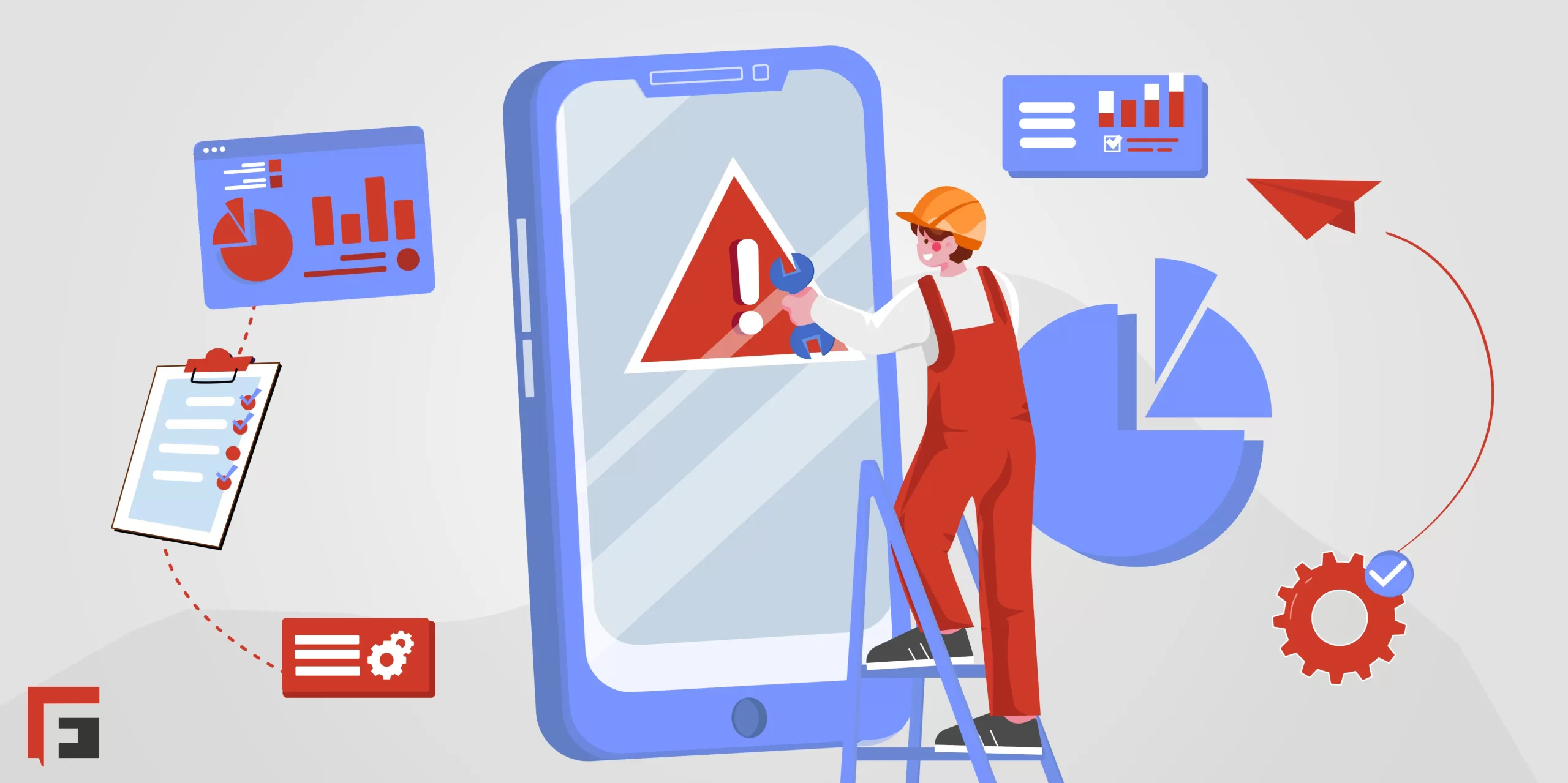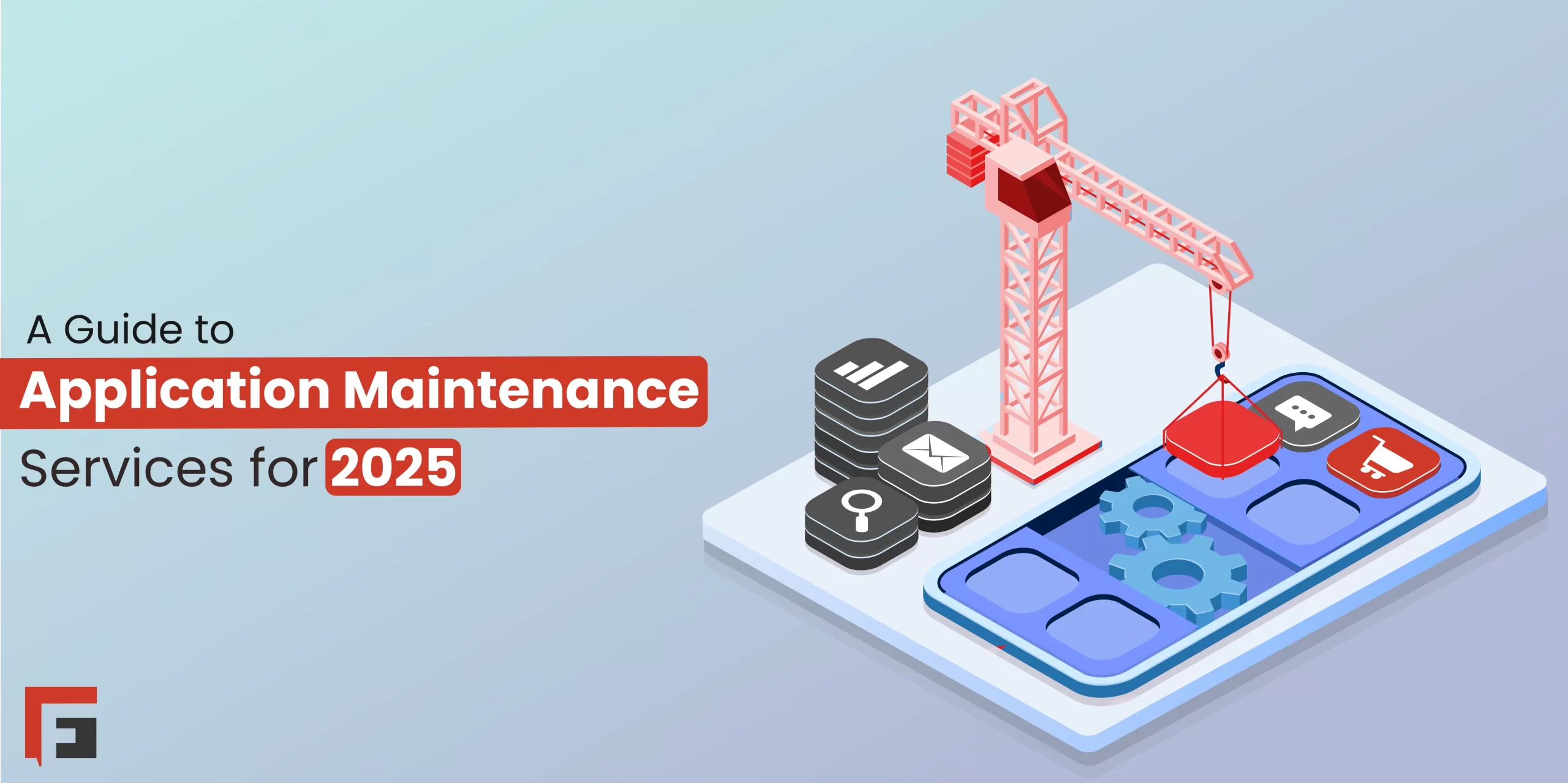
A Guide to Application Maintenance Services for 2025
| Author: | Hagar Hadad |
|---|---|
| Last updated: | |
| Categories: | Application Maintenance |
| Reading time: | 19 mins |
Applications have transformed the way businesses operate, serving as crucial components for efficiency and customer interaction. However, the journey doesn’t end after launching an application; continuous maintenance and support are vital to keep these systems running smoothly, which is why application maintenance services are important.
Investing in high-quality maintenance and support is important for ensuring long-term effectiveness and reliability of software solutions. Often, businesses tend to ignore and disregard the importance of ongoing maintenance once the application is out. This is problematic because regular maintenance is an essential and unavoidable aspect of managing any application.
Failing to maintain your applications or even work with an application maintenance company to do that for you can result in significant losses, including costly financial penalties and operational disruptions for both clients and companies. This is why it’s important to incorporate maintenance and support into the development process. By having application maintenance services, you’ll proactively address any issues that may arise during the application’s operation, which helps maintain seamless functionality and avoids potential challenges.
What is Application Maintenance?
Application maintenance is a process that has a range of activities aimed at updating and optimizing software applications to keep them functioning smoothly. This means that you identify and fix bugs, make necessary updates to adapt to new software, replace outdated functionalities with newer ones, and introduce new features based on user feedback that you get.
Application support is also part of the application maintenance services; it means you provide ongoing assistance to users, ensuring that they can use the application effectively. Application maintenance services include troubleshooting issues, answering user inquiries, and providing training when necessary.
Why is Application Maintenance Important?
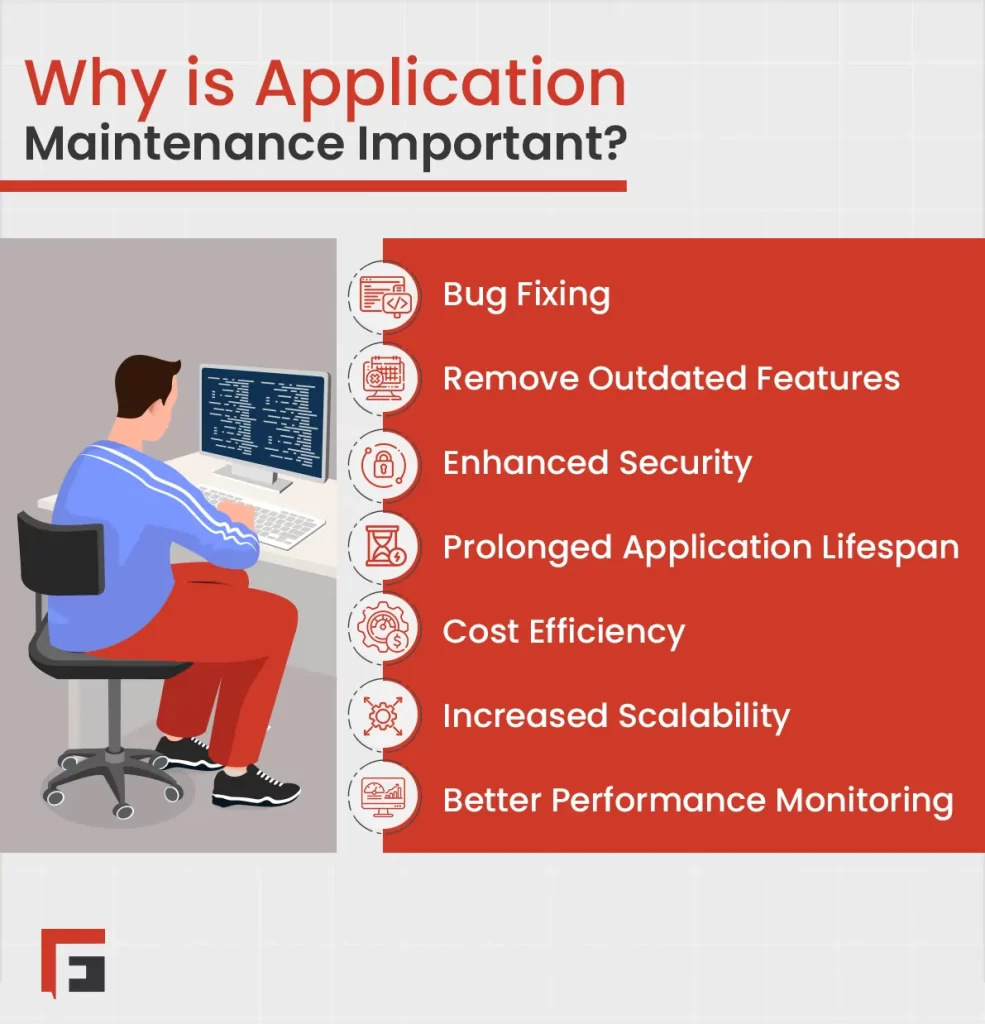
Without proper maintenance, applications can become outdated, hard to use, and ineffective, leading to decreased productivity and user dissatisfaction. In fact, research from the Standish Group indicates that approximately 66% of software projects experience challenges, many of which stem from insufficient maintenance and support. Also, the Ponemon Institute revealed that the average cost of downtime is $9,000 per minute, highlighting the importance of timely maintenance to avoid significant financial losses.
Benefits of Application Maintenance
There are several benefits to having regular application maintenance services, including the following:
Bug Fixing
Tackling and fixing bugs is a crucial element of any kind of application maintenance, including mobile app maintenance. The process of identifying and correcting these issues is vital for maintaining a seamless and efficient operational environment. Experienced maintenance professionals have the expertise to analyze the code and solve errors while ensuring that the system experiences minimal to no downtime.
Remove Outdated Features
Removing outdated features is essential for achieving optimal performance. Keeping unnecessary features can consume valuable resources and negatively impact the efficiency of your application. Having regular application maintenance services helps keep it streamlined and functioning at its highest potential. This proactive approach allows for enhanced performance and a better user experience.
Enhanced Security
It is important to prioritize the security of your application, particularly when it involves managing user data. Even a small data breach can lead to a significant loss. Regular maintenance strengthens your application’s defenses against potential external threats, protecting your company’s reputation and the sensitive information of your customers. By staying proactive and doing timely updates, you can help avoid risks and ensure a safer experience for all users.
Prolonged Application Lifespan
Consistent maintenance of applications ensures that they remain compatible with advancing technologies. By doing this, you’ll prolong their usability and also help avoid expensive replacements. Having regular application maintenance services will help organizations adapt to new technological developments and sustain operational efficiency, ultimately saving money.
Cost Efficiency
Investing in maintenance is more economical than dealing with the financial cost of system failures that can lead to rebuilding from scratch or security incidents. By performing timely maintenance on your own or using an application maintenance company, you can enhance the longevity of your application, thereby maximizing your return on investment while significantly reducing the likelihood of severe and expensive malfunctions. A study by Gartner highlights that application development and maintenance can cut costs by more than 50%.
Increased Scalability
Consistently receiving application maintenance services enables applications to adapt and grow with the business, ensuring they can handle a rise in user demands smoothly and efficiently, without encountering major problems. This ongoing mobile app maintenance, or any kind of maintenance, ensures that as the business expands, the applications remain robust and capable of managing increased loads and complexity.
Better Performance Monitoring
Continuous mobile app maintenance services facilitate the regular assessment of application performance, which is crucial for pinpointing specific areas that need improving. This approach ensures that the software remains efficient and aligned with user needs and expectations.
What Are Challenges in Application Maintenance
1. Skills Gap
The rapid evolution of technology has created a huge skills gap in many organizations. As a result, it can be difficult to locate and keep qualified staff who have the expertise required to do effective app maintenance services. This shortage can lead to delays in implementing updates and security patches, which increases the risk of vulnerabilities. These challenges prove the importance of developing strategies to attract talent capable of navigating the complexities of modern technology.
2. Budget Constraints
Having insufficient funding to support the application maintenance services can pose a significant challenge for many organizations. Budget constraints often force companies to make tough decisions, which could lead to compromises in both the performance and security of their applications. This financial pressure can result in prioritizing certain projects over others, potentially neglecting critical updates and maintenance that are important for maintaining optimal functionality.
3. Increasing Cybersecurity Threats
With cyber threats continuously growing, maintenance teams are under pressure to monitor and respond to vulnerabilities regularly. Rapidly evolving security challenges require organizations to implement protective measures. Teams must create a balance between the urgency of these updates and their existing workloads to protect the application maintenance services offered to them, highlighting the critical need for efficient resource management in the face of evolving security risks.
4. Resource Allocation Issues
Companies sometimes manage multiple applications across various departments, which can lead to neglecting some applications, like mobile application maintenance. This results in receiving insufficient support due to limited resources and impacting the overall efficiency and performance of the organization.
5. Complexity of Legacy Systems
Many companies still depend on legacy applications that were not designed for modern environments and need a lot of application maintenance services. This can create challenges when it comes to updates and maintenance, as integrating modern technologies with these outdated systems often needs significant resources and a lot of planning.
Read Legacy Application Modernization
Types of Application Maintenance
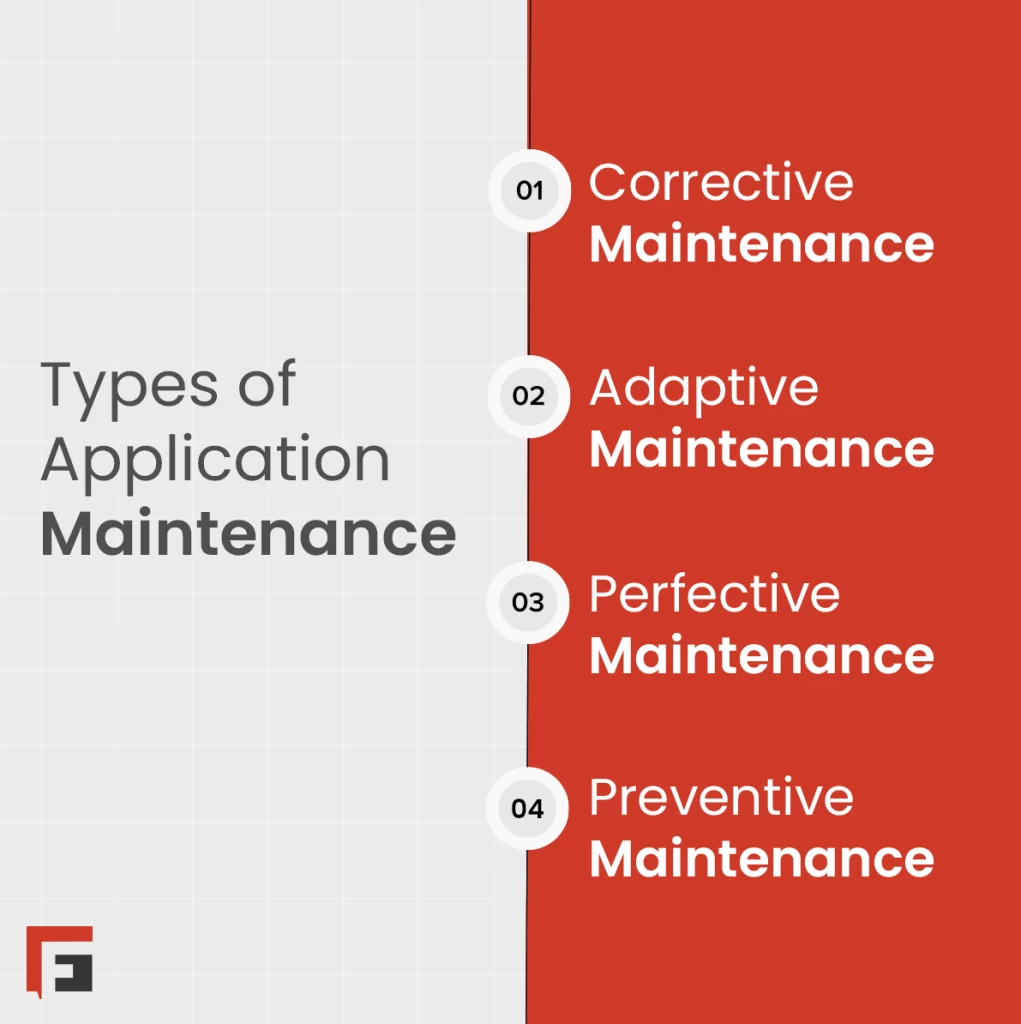
To effectively manage app maintenance services, it is essential to understand the different types.
1. Corrective Maintenance
It is aimed at identifying and fixing defects or bugs that negatively impact the performance of an application. This approach is reactive, as it addresses problems only after they have occurred. The primary goal of corrective maintenance is to ensure that disruptions to the application’s functionality are kept to a minimum. This allows for swift resolutions that help maintain overall system stability and protect the application maintenance services.
2. Adaptive Maintenance
This type of application maintenance focuses on modifying applications to ensure their continued compatibility with emerging systems and software environments as technology evolves. This is essential for helping applications remain relevant and functional in the face of constant technological change. By implementing adaptive maintenance, companies ensure that their applications effectively integrate with the latest advancements, preventing problems and enhancing their ability to meet current user needs and operational requirements.
3. Perfective Maintenance
Perfective maintenance involves making enhancements and changes to an application based on user feedback and performance metrics. The main objective of this maintenance is to boost the application’s functionality and overall efficiency. This is one of many examples of why application maintenance services are important. By focusing on this, organizations can ensure that their applications remain effective and relevant.
4. Preventive Maintenance
Lastly, preventive maintenance aims to detect and address potential issues before they develop into more serious problems. This proactive strategy is designed to reduce the likelihood of significant complications arising in the future. By regularly maintaining applications, companies can ensure that they function smoothly and efficiently. This approach enhances the reliability of the applications and helps extend their lifespan, ultimately minimizing downtime and preserving user satisfaction. A study by Deloitte highlighted that it increases productivity by 25%, reduces breakdowns by 70%, and lowers maintenance costs by 25%.
Difference Between Application Maintenance and Application Modernization
Application maintenance services include the ongoing support and management required to keep software applications functioning efficiently over time. This means that there is a variety of tasks involved, including bug fixes, security updates, performance optimizations, and minor feature improvements. The main objective is to ensure that the application remains stable and reliable, which allows users to perform all their tasks without interruptions or problems. Regular app maintenance services can extend the lifespan, reduce downtime, and enhance user satisfaction.
Application modernization, on the other hand, is the process of updating and transforming existing applications to meet business needs and technological advancements. This is different from application maintenance services as modernization rewrites legacy code, migrates applications to cloud-based platforms, adopts microservices architectures, and integrates modern development frameworks. The aim of modernization is to enhance the application’s scalability, performance, and adaptability.
While both app maintenance services and application modernization are important for effective application management services, they serve different purposes. Maintenance focuses on keeping an already existing system running smoothly. In contrast, modernization is a proactive and I transformative strategy aimed at reviving applications to meet future challenges and opportunities.
Best Practices for Application Maintenance
1. Develop a Comprehensive Maintenance Plan
Creating a thorough maintenance plan is essential for effectively and actively managing application support activities. This plan should outline responsibilities, schedules, and procedures for regular updates and support needed during the application maintenance services.
2. Establish a Partnership with Experts
Ask for the support of a more experienced entity, like an application maintenance company, that has a deep understanding of both the creation and maintenance of high-quality applications. It is important to choose a place with experience in the industry, as well as one that demonstrates effective communication and dedication to providing continuous support throughout the whole journey.
3. Prioritize User Feedback
Gathering and prioritizing user feedback is essential for ongoing improvements in all applications, including web application maintenance services. By consistently collecting and analyzing feedback, organizations can pinpoint specific areas that require improvement. When companies actively add and edit features that users request, it can lead to a substantial increase in user satisfaction and engagement, creating a more user-centric experience and ultimately driving greater loyalty and usage of their applications.
4. Educate the Team
To deliver great results, it’s important that you educate your own team and internal staff. Invest in good team training, especially for new applications and updates to existing ones, to deliver the best results.
5. Implement Security Protocols
As the frequency of cyber threats continues to rise, it has become essential for organizations to add robust security measures. Security is strongly associated with application maintenance services. A study found that 82% of data breaches involve a human element, highlighting the importance of comprehensive security training and awareness programs for employees.
6. Monitor Performance Metrics
Frequent evaluation of performance metrics is important so that companies can follow up with new trends and potential issues before they become a problem. Monitoring key performance indicators, including load times, user engagement levels, and error rates can help organizations gain critical insights that improve their maintenance strategies.
Outsourcing Application Maintenance
Outsourcing application maintenance and support has become a highly favored strategy among a lot of organizations wanting to optimize their operational efficiency and streamline their resources. By engaging with an application maintenance company, organizations can ensure that their applications are maintained to the highest standards, benefiting from up-to-date knowledge of industry trends and technological advancements.
Benefits of Outsourcing Application Maintenance Services
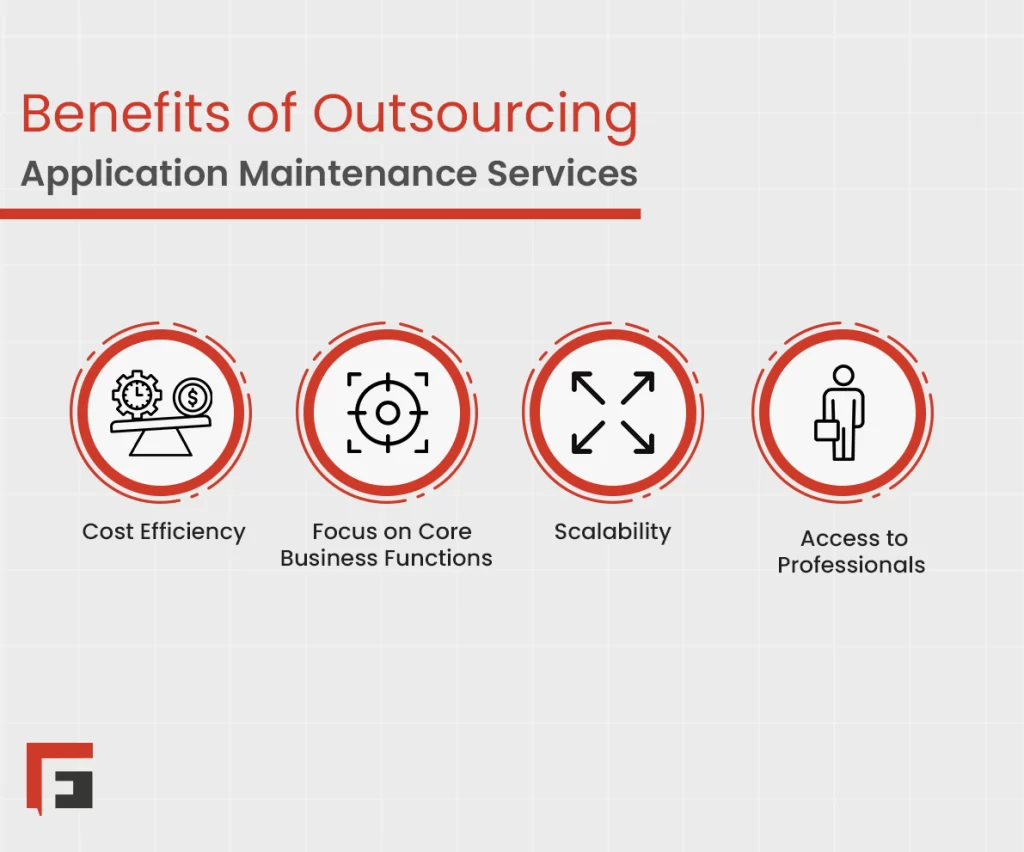
Cost Efficiency
One of the most attractive benefits of outsourcing is the huge reduction in costs associated with staffing and training. Companies often face high expenses related to hiring and retaining skilled professionals, along with the need to provide ongoing training and updates to keep pace with technological advancements. This can be avoided by choosing a provider who offers all kinds of services, including web app maintenance services.
This financial relief enables organizations to reallocate their resources more strategically, investing in areas that directly contribute to growth and innovation. By minimizing overhead expenses, businesses can improve their profit margins while maintaining or even enhancing the quality of application support instead of paying a lot of money for their application maintenance services.
Focus on Core Business Functions
Outsourcing all kinds of application maintenance, including mobile app maintenance, enables organizations to shift their focus toward core business functions and strategic initiatives. By giving the responsibilities of maintenance to an application maintenance company, organizations can concentrate on other activities that also need focus.
This enhanced focus can lead to increased innovation and growth as resources are directed toward efforts that drive competitive advantage. Additionally, by removing the burden of routine maintenance tasks, companies can create a better work environment where teams are encouraged to explore new ideas and initiatives that contribute to long-term success instead of only working on application maintenance services.
Scalability
One of the biggest advantages of outsourcing any kind of service is the scalability that comes with it. Companies enjoy the freedom they get when they decide to outsource because they have a choice to determine the amount of help they’re getting. As business needs fluctuate, particularly during periods of heightened activity or project demands, outsourcing provides the flexibility to adjust maintenance efforts accordingly.
This adaptability ensures that resources are used efficiently, allowing organizations to get a lot of support during critical times without the need for extensive internal restructuring. On the other hand, during quieter times, organizations can scale back their outsourcing application maintenance services. This is especially important due to today’s fast-paced business environment, where the ability to adapt quickly can be a key differentiator between you and your competitor.
Access to Professionals
Outsourcing cuts costs and also provides organizations with access to a wider pool of specialized skills and expertise that may not be available in-house. Collaborating with third-party service providers allows organizations to ensure that their applications are maintained by professionals who possess extensive knowledge of the latest technologies, industry standards, and best practices.
This access to expertise is particularly valuable in an era where technological advancements occur rapidly, as it allows organizations to stay ahead of the curve and implement innovative solutions using application maintenance services that enhance application performance and user experience. Furthermore, these experts are often knowledgeable in various industries, bringing helpful insights that can drive improvements and optimizations.
Potential Challenges in Outsourcing Application Maintenance
While the advantages of working with an application maintenance company are numerous, it is important to recognize the potential challenges that can arise from this approach.
Communication Barriers
Effective communication is vital for any successful partnership, and outsourcing can introduce some challenges in this area. For instance, differences in time zones, while beneficial, can still create a communication problem. Also, language barriers and cultural differences can hinder clear and timely exchanges of information, potentially hurting the application maintenance services offered.
In addition, misunderstandings can arise from misinterpretations or lack of context, leading to errors. To control this challenge, organizations should establish regular communication protocols, use collaboration tools, and ensure that all parties involved have a mutual understanding of project goals and expectations. This will help overcome the communication challenge and ensure a smooth and seamless experience.
Varying Service Levels
Not all outsourcing companies provide the same level of service, which can lead to inconsistencies in the quality of the app maintenance services. Differences in expertise, responsiveness, and adherence to application maintenance services best practices can impact the overall effectiveness of the outsourcing arrangement, which can greatly affect the business.
To address this challenge, organizations must carefully choose potential partners, reviewing their track records and client testimonials. Additionally, establishing clear service level agreements (SLAs) that define expectations, performance metrics, and penalties for non-compliance can help ensure that service levels are maintained.
Data Security and Compliance Concerns
When outsourcing application maintenance, organizations must be clear about data security and compliance with industry regulations. Sharing sensitive information with third-party vendors can expose organizations to potential data breaches and legal liabilities. Also, cyber threats are increasing every day, which is why both the company and the outsourcing provider offering application maintenance services must take security measures to prevent that from happening.
It is essential to conduct thorough research on outsourcing partners to ensure they have strong security measures and compliance protocols in place for protection. Organizations should also include data protection clauses in their contracts and regularly audit their partners to ensure ongoing adherence to security standards.
Cultural Differences
Outsourcing can often involve collaborating with teams from diverse cultural backgrounds, which can lead to different work styles, attitudes toward deadlines, and approaches to problem-solving. This can lead to conflicts or frustrations while receiving application maintenance services.
Companies should invest time in understanding the cultural dynamics of their outsourcing partners and establish a framework for collaboration that respects these differences. Cultural sensitivity training for both internal teams and external partners can also facilitate smoother interactions and ensure a healthy work environment.
Dependency on External Providers
Outsourcing, while beneficial, can create a dependency on external providers for critical application maintenance functions. This reliance may be harmful if the application maintenance company experiences operational difficulties, undergoes changes in management, or even ceases to operate altogether. The results of this problem could be costly, in addition to the time and resources you’ll lose in the process.
To prevent this risk, organizations should maintain some level of in-house knowledge and expertise, ensuring that they are not completely reliant on their outsourcing application maintenance services.
What to Expect from Application Maintenance Services in 2025
The landscape of application maintenance is expected to undergo transformative changes driven by advancements in technology and evolving user expectations. Organizations can expect app maintenance services to become more proactive and data-driven, leveraging artificial intelligence (AI) and machine learning (ML). This will result in maintenance teams anticipating issues before they arise, significantly reducing downtime and optimizing application performance.
Read More about AI application Maintenance
Integration of Automation Tools
The integration of automation tools will streamline routine maintenance tasks, allowing for quicker updates while minimizing human error. As cybersecurity threats continue to escalate, application maintenance services will also prioritize strong security protocols, with continuous monitoring and rapid response mechanisms to address vulnerabilities in real-time before escalating.
User-Centric Principles
User-centric principles will guide the maintenance process, ensuring that feedback from end users is systematically incorporated into updates and enhancements, fostering greater user satisfaction and engagement. This will result in customers choosing to use the applications more often as it is convenient and easy.
Flexibility and Scalability
It’s expected that there will be a more flexible and scalable maintenance approach, enabling organizations to adjust resources based on usage patterns and business needs. This will make all application maintenance services easy and up-to-date while prioritizing agility, security, and user experience, enabling organizations to thrive in a fast-paced, technology-driven world.
Application maintenance is a critical component of any successful strategy. By understanding the various aspects of maintenance and implementing best practices, companies can enhance their application performance, improve user satisfaction, and ultimately drive business success. With the increasing reliance on technology, investing in effective application maintenance is a necessity. As technology continues to evolve, businesses that prioritize these processes will be better positioned to adapt and thrive in a competitive landscape.
At FlairsTech, we understand the importance of having reliable application maintenance services, including application maintenance mobile, and we offer the expertise and talent needed to quickly and effectively improve your business. We have a dedicated team who is multilingual and available 24/7 to help. Contact us now!
Frequently Asked Questions
- What are application maintenance services?
App maintenance services refer to the ongoing support, enhancement, and management of applications to ensure their optimal performance, security, and user satisfaction throughout their lifecycle.
- Why is application maintenance important in 2025?
It’s important because technology is rapidly evolving. This means that maintaining applications is becoming critical to address new security threats, integrate emerging technologies, and meet changing user expectations. Effective maintenance ensures applications remain functional and relevant in a competitive landscape.
- How can organizations improve their application maintenance strategies?
Companies can enhance their strategies by leveraging data analytics for insights, implementing automation tools, ensuring compliance with regulations, and fostering collaboration between maintenance teams and end-users for continuous useful feedback.
- Is outsourcing application maintenance services useful?
Yes, outsourcing is beneficial for many organizations, as it often leads to cost savings, access to specialized expertise, and the ability to focus on core business functions. By outsourcing some activities, companies can allocate resources more efficiently and enhance operational agility.
- What are the challenges of outsourcing application maintenance services?
Challenges include communication barriers, cultural differences, varying service levels, and dependency on external providers.
- How can user feedback influence application maintenance?
Incorporating user feedback into maintenance efforts allows organizations to address user needs effectively, enhance application functionality, and foster greater user satisfaction and engagement.
- How can companies ensure data security during application maintenance?
Businesses can improve data security by implementing strong security protocols, conducting regular audits, and training staff on security best practices.


